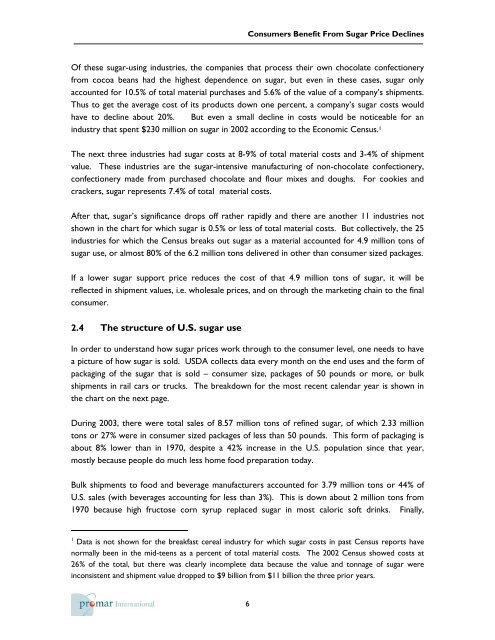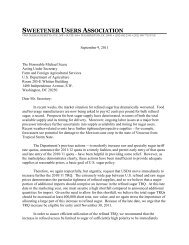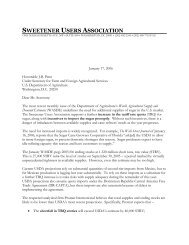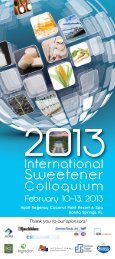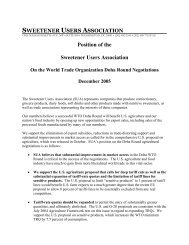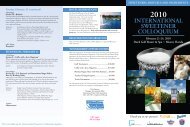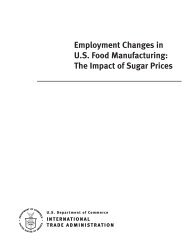Consumers Benefit From Competitive Sugar Prices - Sweetener ...
Consumers Benefit From Competitive Sugar Prices - Sweetener ...
Consumers Benefit From Competitive Sugar Prices - Sweetener ...
You also want an ePaper? Increase the reach of your titles
YUMPU automatically turns print PDFs into web optimized ePapers that Google loves.
<strong>Consumers</strong> <strong>Benefit</strong> <strong>From</strong> <strong>Sugar</strong> Price DeclinesOf these sugar-using industries, the companies that process their own chocolate confectioneryfrom cocoa beans had the highest dependence on sugar, but even in these cases, sugar onlyaccounted for 10.5% of total material purchases and 5.6% of the value of a company’s shipments.Thus to get the average cost of its products down one percent, a company’s sugar costs wouldhave to decline about 20%. But even a small decline in costs would be noticeable for anindustry that spent $230 million on sugar in 2002 according to the Economic Census. 1The next three industries had sugar costs at 8-9% of total material costs and 3-4% of shipmentvalue. These industries are the sugar-intensive manufacturing of non-chocolate confectionery,confectionery made from purchased chocolate and flour mixes and doughs. For cookies andcrackers, sugar represents 7.4% of total material costs.After that, sugar’s significance drops off rather rapidly and there are another 11 industries notshown in the chart for which sugar is 0.5% or less of total material costs. But collectively, the 25industries for which the Census breaks out sugar as a material accounted for 4.9 million tons ofsugar use, or almost 80% of the 6.2 million tons delivered in other than consumer sized packages.If a lower sugar support price reduces the cost of that 4.9 million tons of sugar, it will bereflected in shipment values, i.e. wholesale prices, and on through the marketing chain to the finalconsumer.2.4 The structure of U.S. sugar useIn order to understand how sugar prices work through to the consumer level, one needs to havea picture of how sugar is sold. USDA collects data every month on the end uses and the form ofpackaging of the sugar that is sold – consumer size, packages of 50 pounds or more, or bulkshipments in rail cars or trucks. The breakdown for the most recent calendar year is shown inthe chart on the next page.During 2003, there were total sales of 8.57 million tons of refined sugar, of which 2.33 milliontons or 27% were in consumer sized packages of less than 50 pounds. This form of packaging isabout 8% lower than in 1970, despite a 42% increase in the U.S. population since that year,mostly because people do much less home food preparation today.Bulk shipments to food and beverage manufacturers accounted for 3.79 million tons or 44% ofU.S. sales (with beverages accounting for less than 3%). This is down about 2 million tons from1970 because high fructose corn syrup replaced sugar in most caloric soft drinks. Finally,1 Data is not shown for the breakfast cereal industry for which sugar costs in past Census reports havenormally been in the mid-teens as a percent of total material costs. The 2002 Census showed costs at26% of the total, but there was clearly incomplete data because the value and tonnage of sugar wereinconsistent and shipment value dropped to $9 billion from $11 billion the three prior years.6


